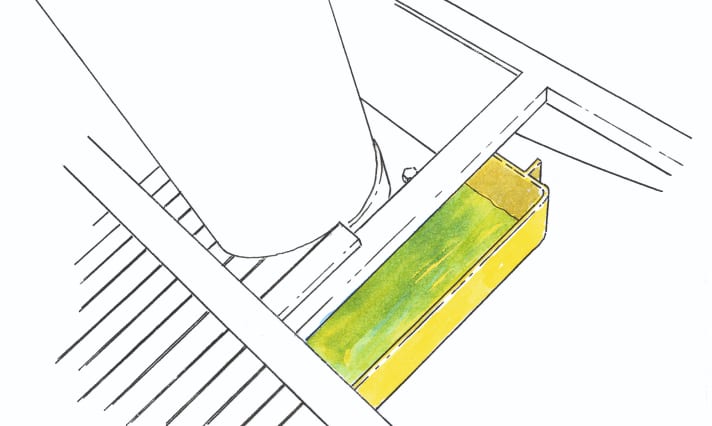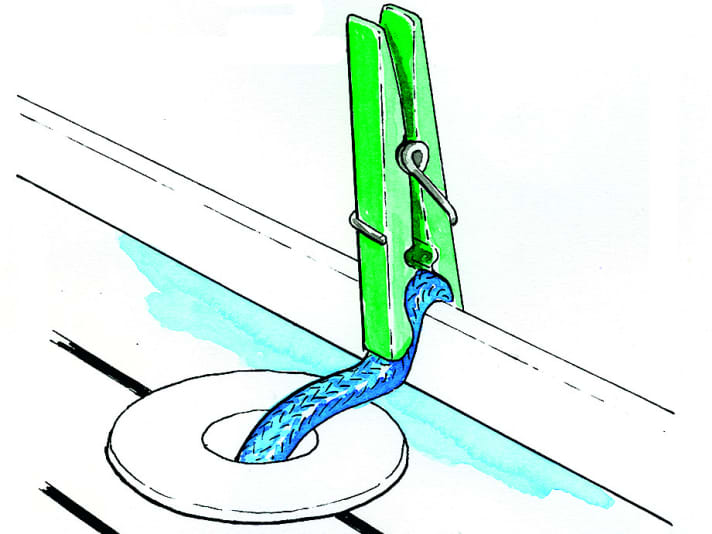
- Rain Lifehack 1: An article from the sanitary sector protects against water ingress
- Rain lifehack 2: Splash water roller blind for the companionway
- Rain lifehack 3: Simple measure for a dry deck and against rain streaks on the hull
- Rain Lifehack 4: So the rain doesn't get into the mast
- Rain lifehack 5: So the rain doesn't get into the mast 2
- Rain lifehack 6: A tray collects the rainwater
- Rain lifehack 7: Dry thanks to the wick effect
- Rain Lifehack 8: Ventilation with textile weather protection
- Rain-Lifehack 9: This clever tarpaulin offers protection from rain showers and sun
- Rain Lifehack 10: So the rain runs off the tarpaulin better
- Do you have any advice for other sailors?
Rain Lifehack 1: An article from the sanitary sector protects against water ingress

Humid air is the natural enemy of all textiles in the cabin. A simple remedy for high humidity is ventilation. However, if more water gets into the boat than is bound up in the air and gets out through the hatch, the calculation doesn't work. To keep the boat ventilated while we were away in harbour, we came up with a rain cover for the cockpit hatch: we cut a piece of PVC pipe in half lengthways and drilled two holes in it. We threaded rubber bands through the holes, which in turn were attached to a wooden strut. The connection must be tight enough to hold the pipe half in position. The holes should also be drilled slightly below the centre so that no water can penetrate and get into the inside of the boat along the rubber straps. We also use the cover when we are on board and want to ventilate on a rainy day. When not in use, it takes up very little space in the cockpit locker.
Hayo Koch, Dorsten
Rain lifehack 2: Splash water roller blind for the companionway

Without a sprayhood, it quickly rains into the open companionway. Keeping the bulkhead closed all the time is uncomfortable. We have therefore made a tarpaulin roller blind. The curtain is attached to the sliding hatch with two Tenax buttons. To prevent the tarpaulin from blowing up in strong winds, we sewed a tube filled with curtain lead into the lower end. In this way, the companionway can be closed quickly whenever it rains. Once the rain has passed, the tarpaulin is rolled up around the tube and placed on the sliding hatch.
Wilfried Korff, Düsseldorf
Rain lifehack 3: Simple measure for a dry deck and against rain streaks on the hull

Standing water damages the teak deck in the long term and can lead to leaks at the joints. There are some areas on our boat where the water does not drain away from the teak poles. To prevent damage to the deck, we have sewn a piece of canvas to a strip of foam rubber. This sausage is inserted through the holes in the foot rail at the appropriate points before leaving the boat. They soak up the water, which then drips off to the outside. This ensures that these problem areas dry out quickly and protects the deck.
Dirk Sommer, Bebensee
Rain Lifehack 4: So the rain doesn't get into the mast

During the winter months, our boat stands ashore with the mast in place. In the past, rainwater ran along the spinnaker halyard into the mast and collected in the bilge. The only thing that helped was to hoist up before the crane and tie the spinnaker halyard down. And while you're up there, you can also stick a strip of tape to the opening in the mast. This keeps our bilge dry, at least in winter, and prevents spillage below deck.
Janni Maraner, Bolzano
Rain lifehack 5: So the rain doesn't get into the mast 2

A new old boat and new problems: After every long period of rain, there was water in the bilge because the plug inside the mast was no longer tight. To prevent the water from running into the mast in the first place, we installed deflectors above the drop outlets. To do this, we used small stainless steel plates, such as those available in the accessories trade. To prevent electrolysis, the deflector is lined with tarpaulin fabric.
Paul Sterzer, Munich
Rain lifehack 6: A tray collects the rainwater

Without drainage on deck, through-stepped masts let water into the ship through the halyard outlets when it rains. On ours, there is still some space under the steel mast support. We have cut a plastic tub to size so that it fits under the mast shoe. A foldable tub from an outdoor shop would also be an option. In some weather conditions, the tub collects up to five litres in just a few hours. Our bilge has been dust-dry ever since we used this trick.
Günter Löffler, Uetersen
Rain lifehack 7: Dry thanks to the wick effect

Unfortunately, the deck drains on board our yacht are not installed at the lowest point - so some water always remains on the teak and algae forms. To solve the problem, we use a strong lamp wick. This is clamped onto the skirting board with a clothes peg and placed through the puddle into the drain. This allows the deck to dry much faster.
Dieter Behren, Hanover
Rain Lifehack 8: Ventilation with textile weather protection

Yacht windows usually open inwards - when it rains, the water then runs over the deck directly into the boat. Our solution: A small piping rail is attached above the window to divert the rainwater run-off. In addition, an awning matching the window is tailored with a piping strip that can be tensioned with rubber stoppers. This allows us to ventilate when it rains and the bunks stay dry even during unexpected night-time showers. Piping is available from sailmakers or caravan dealers.
Wolfgang Szulzewski, Rühen
Rain-Lifehack 9: This clever tarpaulin offers protection from rain showers and sun


Our British Drascombe is a small open boat with two masts. In order to have at least some protection against the sun or rain, we made ourselves a special tarpaulin. Initially, this is just a rectangular piece of tarpaulin fabric that is laid over the main boom. The small roof gets its stability from four tent poles. These are inserted at right angles to the direction of travel into elongated pockets sewn under the tarpaulin - but not across the entire width of the sunroof. This is because a 15 centimetre seam remains at the edges, into which we have hammered thimbles. Small brass screws under the surrounding coaming serve as counterparts for fastening. The strap is simply placed around the screw head. This does not interfere as it points downwards under the coaming. The tarpaulin can be perfectly adjusted to the weather conditions by adjusting the straps.
Jochen Peschke, Hamburg
Rain Lifehack 10: So the rain runs off the tarpaulin better

In the harbour, we protect the sprayhood and cockpit from sunlight and rain with an additional tarpaulin. This additional protection is placed over the boom and tensioned over the railing. If the tarpaulin is not taut enough, water pockets will form where it sags on the railing wire. To avoid this unnecessary strain on the tarpaulin and railing, we stretch a line under the tarpaulin between the opposite railing supports over the main boom.
Jochen Peschke, Hamburg
Do you have any advice for other sailors?
We will honour the publication of your lifehack with 50 EURO. Please add photos or sketches. We also need your address and bank details
Submissions to: Editorial office YACHT, Quartier O, Paul-Dessau-Straße 8, 22761 Hamburg; or: mail@yacht.de

